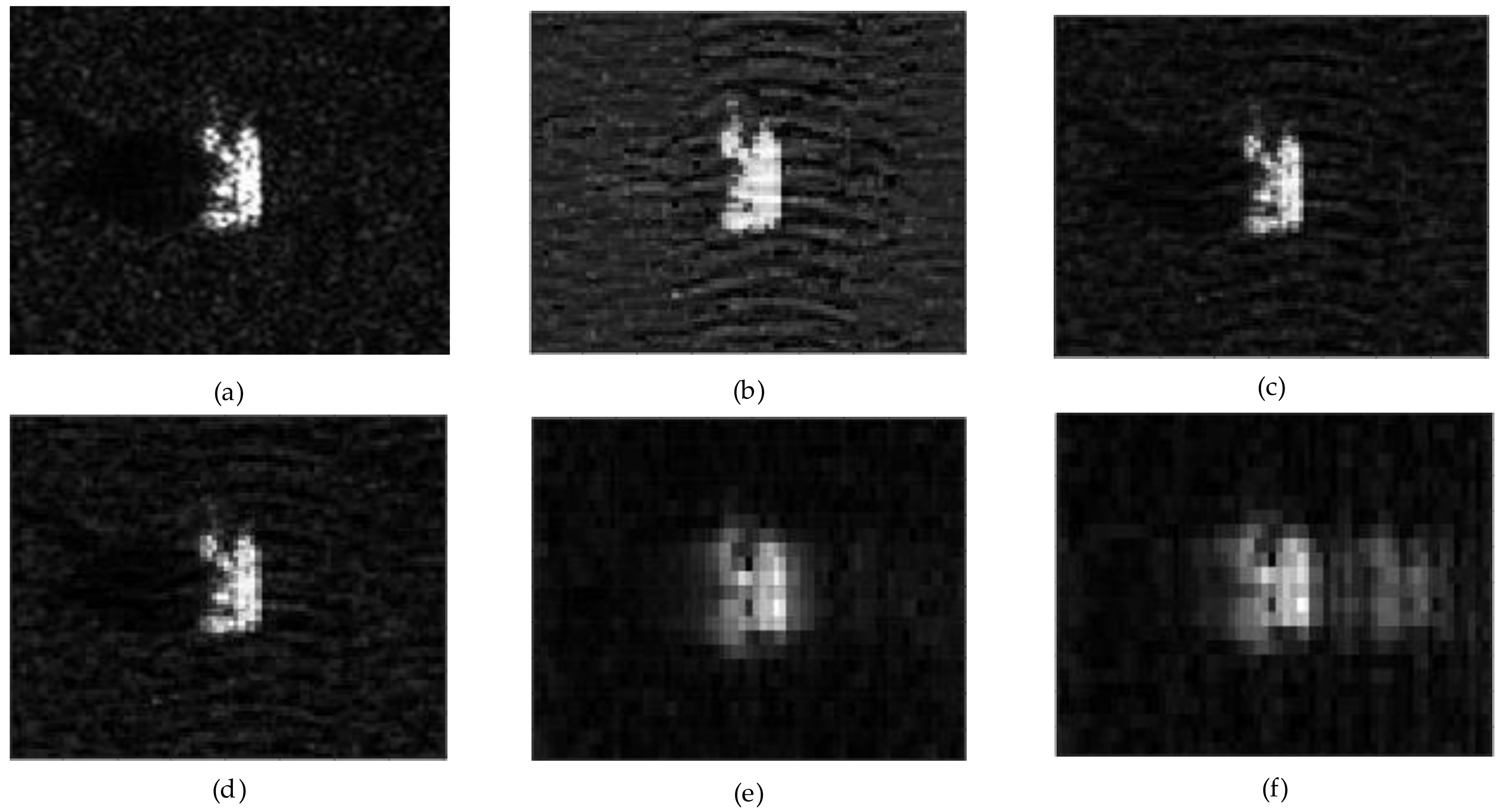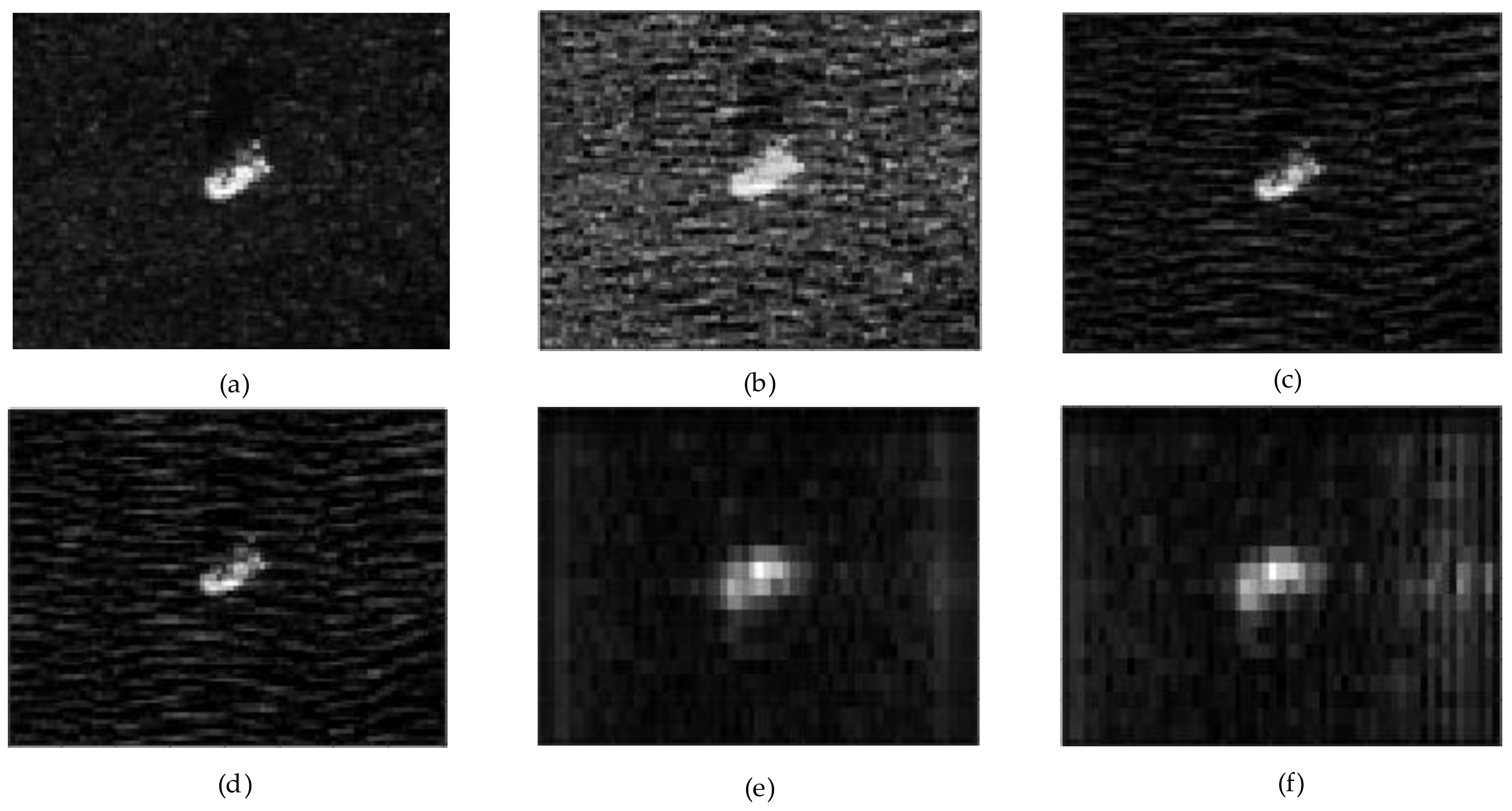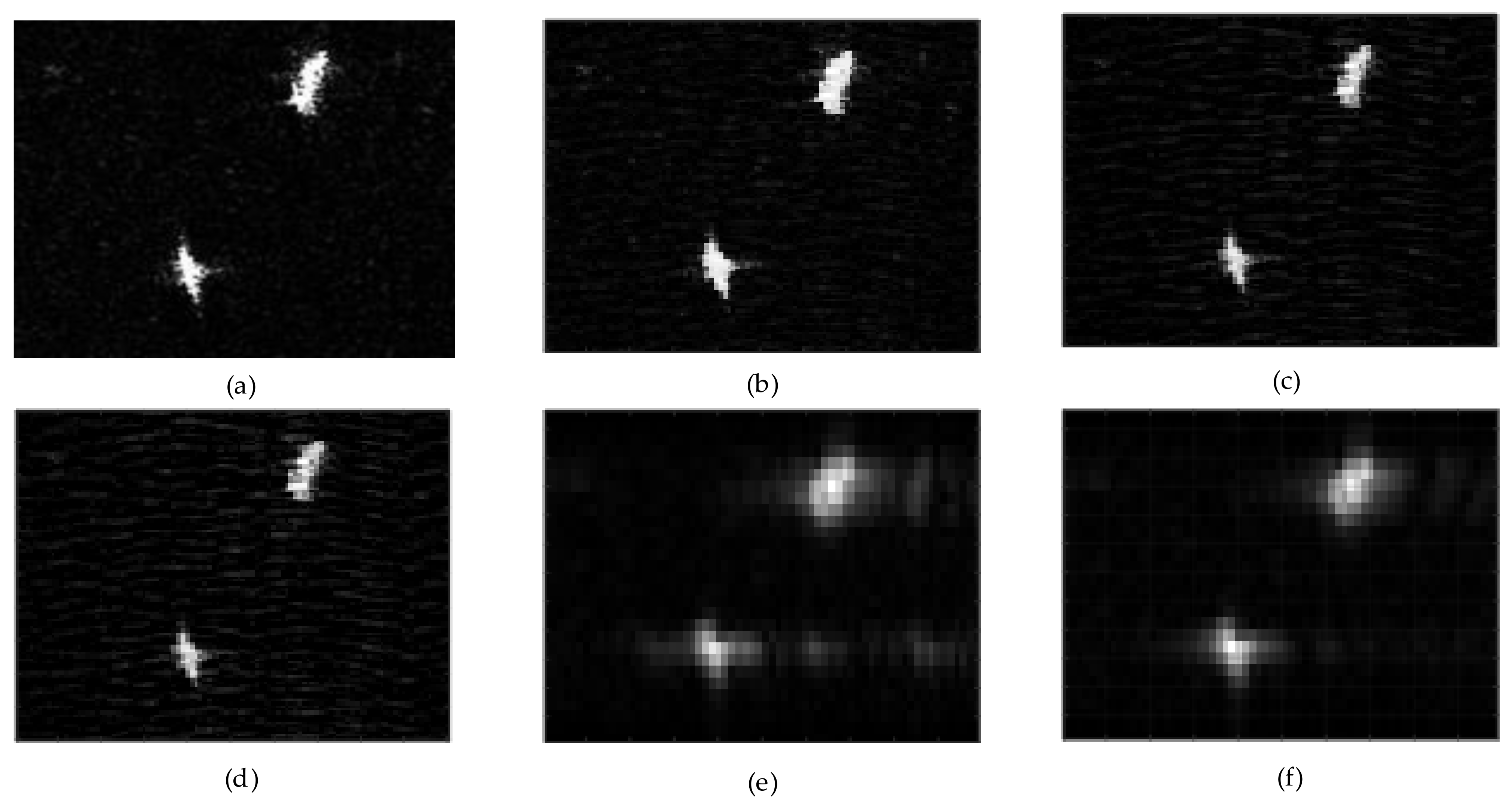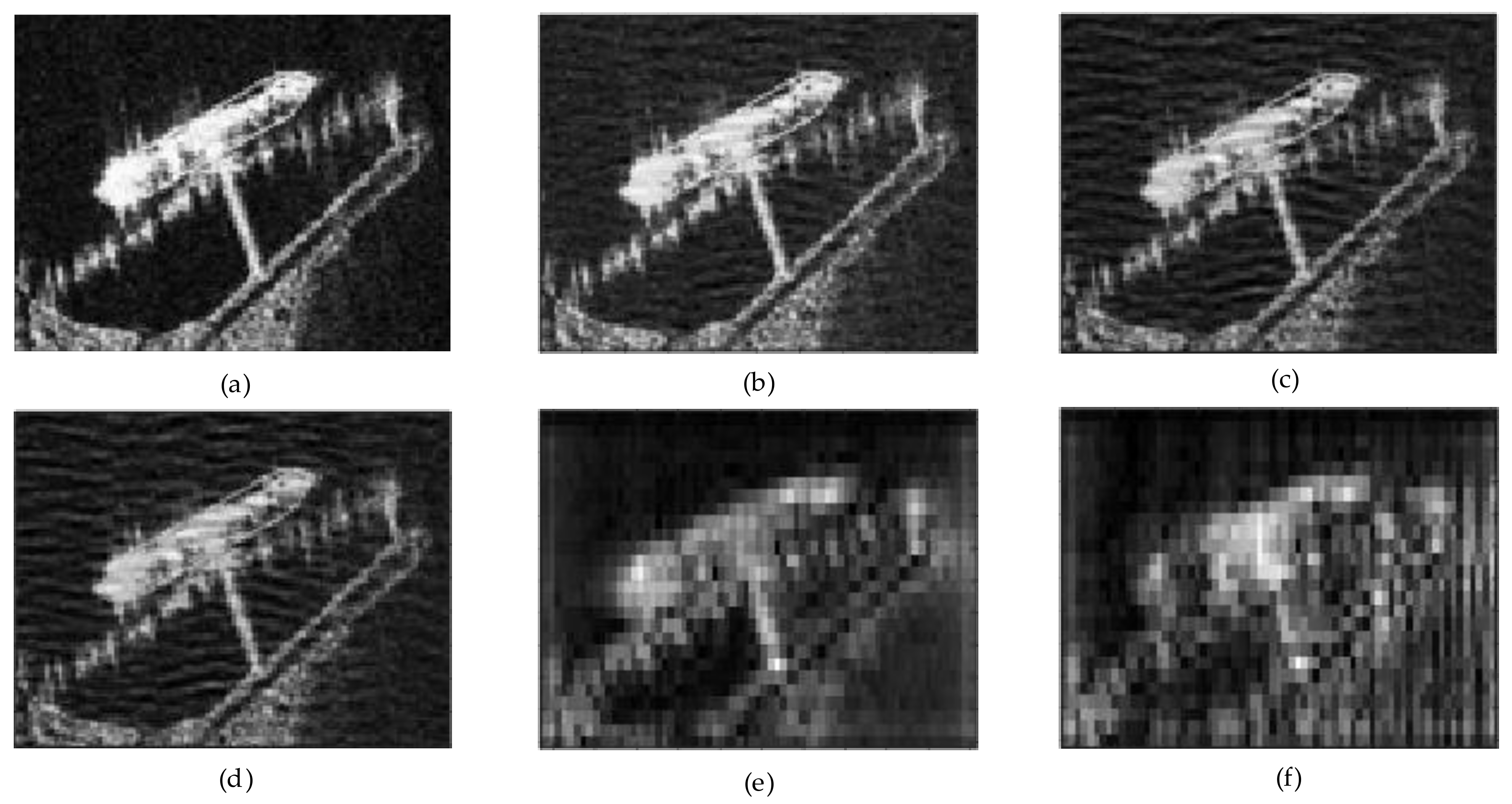End-to-End SAR Deep Learning Imaging Method Based on Sparse Optimization
Abstract
:1. Introduction
- In order to solve the problems of low imaging quality, excessive parameter settings and difficulty in parameter tuning of traditional SAR sparse imaging methods, we proposed a novel end-to-end SAR sparse imaging method based on a neural network.
- The algorithm only performs imaging processing in the two-dimensional data domain and derives it into a neural network imaging model based on iteration soft threshold algorithm (ISTA) sparse algorithm, instead of arranging two-dimensional echo data into a vector to continuously construct an observation matrix. This can greatly reduce the computational cost and make sparse imaging of large-scale scenes possible.
- Compared with the previous methods, which can only reconstruct simple targets of simulated data and smaller scenes, our algorithm is superior to the traditional sparse algorithm in terms of imaging quality, imaging time, and parameter numbers through simulation data and measured data of three kinds of targets.
2. SAR Sparse Imaging Model
2.1. SAR Sparse Imaging Model
2.2. SAR Complex Signal Sparse Imaging Based on a Real-Value Model
2.3. Iterative Optimization of the Sparse Imaging Model Based on L1 Decoupling
3. SAR Deep Learning Imaging Method Based on ISTA
3.1. Construction of the Deep Learning Imaging Network
3.2. Training the Deep Learning Imaging Network
4. Experiments and Analysis
4.1. Simulation Point Target Imaging Experiment
4.2. Measured Target Imaging Experiment
5. Conclusions
Author Contributions
Funding
Institutional Review Board Statement
Informed Consent Statement
Data Availability Statement
Conflicts of Interest
References
- Zhou, F.; Zhao, B.; Tao, M.; Bai, X.; Chen, B.; Sun, G. A large scene deceptive jamming method for space-borne SAR. IEEE Trans. Geosci. Remote Sens. 2013, 51, 4486–4495. [Google Scholar] [CrossRef]
- Xu, Z.; Zhang, B.; Zhou, G.; Zhong, L.; Wu, Y. Sparse SAR Imaging and Quantitative Evaluation Based on Nonconvex and TV Regularization. Remote Sens. 2021, 13, 1643. [Google Scholar] [CrossRef]
- Yang, W.; Chen, J.; Liu, W.; Wang, P.B.; Li, C.S. A Modified Three-Step Algorithm for TOPS and Sliding Spotlight SAR Data Processing. IEEE Trans. Geosci. Remote Sens. 2017, 55, 6910–6921. [Google Scholar] [CrossRef] [Green Version]
- Ni, J.C.; Zhang, Q.; Luo, Y.; Sun, L. Compressed sensing SAR imaging based on centralized sparse representation. IEEE Sens. J. 2018, 18, 4920–4933. [Google Scholar] [CrossRef]
- Bi, H.; Li, Y.; Zhu, D.Y.; Bi, B.A.; Zhang, B.C.; Hong, W.; Wu, Y.R. An improved iterative thresholding algorithm for L1-norm regularization based sparse SAR imaging. Sci. China Inf. Sci. 2020, 63, 219301:1–219301:3. [Google Scholar] [CrossRef]
- Fang, J.; Xu, Z.B.; Zhang, B.C.; Hong, W.; Wu, Y.R. Fast Compressed Sensing SAR Imaging Based on Approximated Observation. IEEE J. Sel. Top. Appl. Earth Obs. Remote Sens. 2014, 7, 352–363. [Google Scholar] [CrossRef] [Green Version]
- Shi, W.; Jiang, F.; Zhang, S.; Zhao, D. Deep networks for compressed image sensing. In Proceedings of the 2017 IEEE International Conference on Multimedia and Expo (ICME), Hong Kong, China, 10–14 July 2017; pp. 877–882. [Google Scholar] [CrossRef] [Green Version]
- Zhang, J.; Ghanem, B. ISTA-Net: Interpretable Optimization-Inspired Deep Network for Image Compressive Sensing. In Proceedings of the 2018 IEEE/CVF Conference on Computer Vision and Pattern Recognition, Salt Lake City, UT, USA, 18–23 June 2018; pp. 1828–1837. [Google Scholar] [CrossRef] [Green Version]
- Zhang, Y.; Mu, H.L.; Xiao, T.; Jiang, Y.C.; Ding, C. SAR imaging of multiple maritime moving targets based on sparsity Bayesian learning. IET Radar Sonar Navig. 2020, 14, 1717–1725. [Google Scholar] [CrossRef]
- Ma, T.; Li, H.; Yang, H.; Lv, X.L.; Li, P.Y.; Liu, T.J.; Yao, D.Z.; Xu, P. The extraction of motion-onset VEP BCI features based on deep learning and compressed sensing. J. Neurosci. Methods 2017, 275, 80–92. [Google Scholar] [CrossRef] [PubMed]
- Liang, P.Z.; Fan, J.C.; Shen, W.H.; Qin, Z.J.; Li, G.Y. Deep Learning and Compressive Sensing-Based CSI Feedback in FDD Massive MIMO Systems. IEEE Trans. Veh. Technol. 2020, 69, 9217–9222. [Google Scholar] [CrossRef]
- Ma, W.Y.; Qi, C.H.; Zhang, Z.C.; Cheng, J.L. Sparse Channel Estimation and Hybrid Precoding Using Deep Learning for Millimeter Wave Massive MIMO. IEEE Trans. Commun. 2020, 68, 2838–2849. [Google Scholar] [CrossRef] [Green Version]
- Cao, X.H.; Ji, Y.M.; Wang, L.; Ji, B.B.; Jiao, L.C.; Han, J.G. SAR image change detection based on deep denoising and CNN. IET Images Process. 2019, 13, 1509–1515. [Google Scholar] [CrossRef]
- Zhou, Y.Y.; Shi, J.; Wang, C.; Hu, Y.; Zhou, Z.N.; Yang, X.Q.; Zhang, X.L.; Wei, S.J. SAR Ground Moving Target Refocusing by Combining mRe3 Network and TVβ-LSTM. IEEE Trans. Geosci. Remote Sens. 2020, 1–14. [Google Scholar] [CrossRef]
- Shi, H.Y.; Lin, Y.; Guo, J.W.; Liu, M.X. ISAR autofocus imaging algorithm for maneuvering targets based on deep learning and keystone transform. J. Syst. Eng. Electron. 2020, 31, 1178–1185. [Google Scholar]
- Shi, W.Z.; Jiang, F.; Liu, S.H.; Zhao, D.B. Image Compressed Sensing Using Convolutional Neural Network. IEEE Trans. Image Process. 2020, 29, 375–388. [Google Scholar] [CrossRef]
- Qin, R.; Fu, X.J.; Dong, J.; Jiang, W. A semi-greedy neural network CAE-HL-CNN for SAR target recognition with limited training data. Int. J. Remote Sens. 2020, 41, 7889–7911. [Google Scholar] [CrossRef]
- Merhej, D.; Diab, C.; Khalil, M.; Prost, R. Embedding Prior Knowledge Within Compressed Sensing by Neural Networks. IEEE Trans. Neural Netw. 2011, 22, 1638–1649. [Google Scholar] [CrossRef] [PubMed]
- Bu, H.X.; Tao, R.; Bai, X.; Zhao, J. A Novel SAR Imaging Algorithm Based on Compressed Sensing. IEEE Geosci. Remote Sens. Lett. 2015, 12, 1003–1007. [Google Scholar] [CrossRef]
- Kang, M.S.; Kim, K.T. Ground Moving Target Imaging Based on Compressive Sensing Framework with Single-Channel SAR. IEEE Sens. J. 2020, 20, 1238–1250. [Google Scholar] [CrossRef]
- Jung, S.; Cho, Y.; Park, R.; Kim, J.; Jung, H.; Chung, Y. High-Resolution Millimeter-Wave Ground-Based SAR Imaging via Compressed Sensing. IEEE Trans. Magn. 2018, 54, 9400504. [Google Scholar] [CrossRef]
- Kang, M.S.; Kim, K.T. Compressive Sensing Based SAR Imaging and Autofocus Using Improved Tikhonov Regularization. IEEE Sens. J. 2019, 19, 5529–5540. [Google Scholar] [CrossRef]
- Khwaja, A.S.; Ma, J.W. Applications of Compressed Sensing for SAR Moving-Target Velocity Estimation and Image Compression. IEEE Trans. Instrum. Meas. 2011, 60, 2848–2860. [Google Scholar] [CrossRef]
- Hou, B.; Wei, Q.; Zheng, Y.; Wang, S. Unsupervised Change Detection in SAR Image Based on Gauss-Log Ratio Image Fusion and Compressed Projection. IEEE J. Sel. Top. Appl. Earth Obs. Remote Sens. 2014, 7, 3297–3317. [Google Scholar] [CrossRef]
- Candés, E.J.; Romberg, J.K.; Tao, T. Stable signal recovery from incomplete and inaccurate measurements. Commun. Pure Appl. Math. 2006, 59, 1207–1223. [Google Scholar] [CrossRef] [Green Version]
- Bi, H.; Bi, G.A.; Zhang, B.C.; Hong, W. Complex-Image-Based Sparse SAR Imaging and Its Equivalence. IEEE Trans. Geosci. Remote Sens. 2018, 56, 5006–5014. [Google Scholar] [CrossRef]
- Luo, Y.; Ni, J.C.; Zhang, Q. Synthetic aperture radar learning-imaging method based on data-driven technique and artificial intelligence. J. Radars 2020, 9, 107–122. [Google Scholar]
- Borgerding, M.; Schniter, P.; Rangan, S. AMP inspired deep networks for sparse linear inverse problems. IEEE Trans. Signal Process. 2017, 65, 4293–4308. [Google Scholar] [CrossRef]
- Ye, G.Y.; Zhang, Z.X.; Ding, L.; Li, Y.W.; Zhu, Y.M. GAN-Based Focusing-Enhancement Method for Monochromatic Synthetic Aperture Imaging. IEEE Sens. J. 2020, 20, 11484–11489. [Google Scholar] [CrossRef]
- Lu, Z.J.; Qin, Q.; Shi, H.Y.; Huang, H. SAR moving target imaging based on convolutional neural network. Digit. Signal Process. 2020, 106, 102832. [Google Scholar] [CrossRef]
- Zhang, J.; Pei, Z. Ground-based SAR imaging based on improved Range-Doppler algorithm. In Proceedings of the International Radar Conference IET, Xi’an, China, 14–16 April 2013. [Google Scholar]









| Symbol | Quantity | Value |
|---|---|---|
| Carrier frequency | 10 GHz | |
| Bandwidth | 150 MHz | |
| PRF | Pulse repetition frequency | 500 Hz |
| Pulse duration | 1.2 | |
| Range resolution | 2 m | |
| Azimuth resolution | 2 m | |
| H | SAR platform altitude | 10,000 m |
| V | SAR platform velocity | 100 m/s |
| Algorithm | PSNR | NMES | PLSR | Imaging Time |
|---|---|---|---|---|
| L = 3 | 21.24 dB | 0.52 | −13.68 dB | 0.02s |
| L = 8 | 32.68 dB | 0.46 | −16.78 dB | 0.06s |
| L = 11 | 34.54 dB | 0.53 | −16.78 dB | 0.25s |
| Range Doppler | 22.65 dB | 0.64 | −16.90 dB | 2.56s |
| ISTA | 23.70 dB | 0.74 | −14.25 dB | 4.32s |
| Fast ISTA | 34.85 dB | 0.92 | −10.65 dB | 2.84s |
| Algorithm | Ground Observation Scene | Sea Surface Observation Scene | Ground Airport Observation Scene |
|---|---|---|---|
| L = 3 | 0.10 s | 0.54 s | 0.98 s |
| L = 8 | 0.12 s | 0.68 s | 1.10 s |
| L = 11 | 0.12 s | 0.60 s | 1.06 s |
| ISTA | 8.67 s | 12.30 s | 14.50 s |
| Fast ISTA | 8.10 s | 11.84 s | 13.96 s |
Publisher’s Note: MDPI stays neutral with regard to jurisdictional claims in published maps and institutional affiliations. |
© 2021 by the authors. Licensee MDPI, Basel, Switzerland. This article is an open access article distributed under the terms and conditions of the Creative Commons Attribution (CC BY) license (https://creativecommons.org/licenses/by/4.0/).
Share and Cite
Zhao, S.; Ni, J.; Liang, J.; Xiong, S.; Luo, Y. End-to-End SAR Deep Learning Imaging Method Based on Sparse Optimization. Remote Sens. 2021, 13, 4429. https://doi.org/10.3390/rs13214429
Zhao S, Ni J, Liang J, Xiong S, Luo Y. End-to-End SAR Deep Learning Imaging Method Based on Sparse Optimization. Remote Sensing. 2021; 13(21):4429. https://doi.org/10.3390/rs13214429
Chicago/Turabian StyleZhao, Siyuan, Jiacheng Ni, Jia Liang, Shichao Xiong, and Ying Luo. 2021. "End-to-End SAR Deep Learning Imaging Method Based on Sparse Optimization" Remote Sensing 13, no. 21: 4429. https://doi.org/10.3390/rs13214429
APA StyleZhao, S., Ni, J., Liang, J., Xiong, S., & Luo, Y. (2021). End-to-End SAR Deep Learning Imaging Method Based on Sparse Optimization. Remote Sensing, 13(21), 4429. https://doi.org/10.3390/rs13214429







